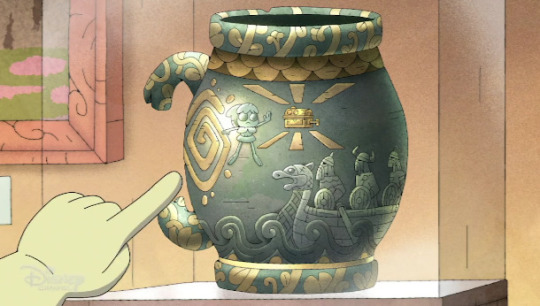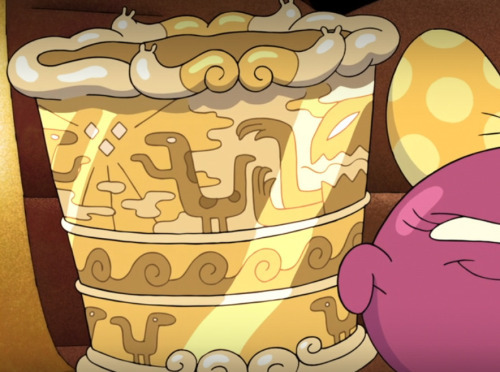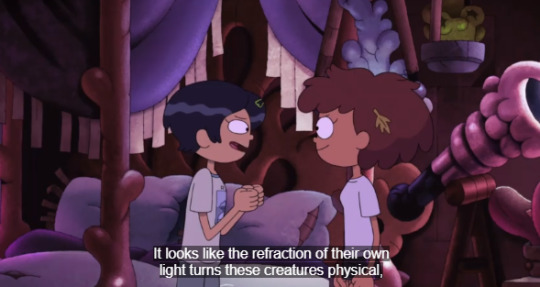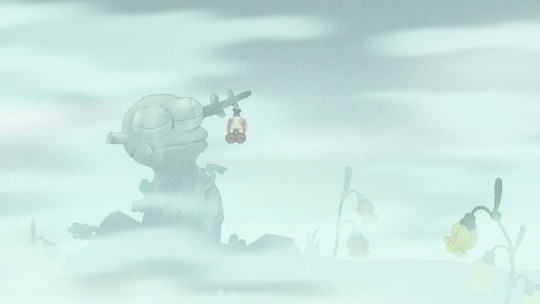#this theory is held together with duct tape and red strings and it's been rotting my brain for two days
Text
I was going through this recurring background elements post when I realized something.


It’s very likely that these are depictions, or at least stylizations, of the same event: a frog presenting three humans with an ancient power.
We, or at least I, have been assuming that the mural in the opening and in the First Temple was the girls fighting the Night, but with last episode’s revelation that the Night is most likely an olm, that no longer makes sense to me. First of all, because the creature depicted on the mural is clearly a frog, or at the very least a toad; secondly, because olms are creatures of darkness, yet this creature seems to be giving out the fire (aka the calamity power) instead of shielding itself from it -

- like the creature on the right (also looking more like an olm) is doing here.
I’m also associating the calamity power with fire, and more broadly with light, because the colors of the three gems (red, green and blue) are the primary components of light, and because light is quite obviously the only thing that can defeat the Night (the prophecy even refers to the three humans as “three stars burning bright”).
As an aside, light also works on the weird creatures in the basement, though I’m not sure if and how they are connected to the Night:


The only difference between the picture on the vase and the mural in the intro is in the humans. The three people the pink frog encountered were obviously Vikings, whereas the people on the mural look a lot like Anne, Sasha and Marcy, and might or might not be them. Even assuming that the people in the intro are our girls, we know there have been other humans in Amphibia before them but after Viking times, because of the walkman in Wax Museum.
So my question is: is it possible that the girls aren’t the end-all-be-all of this prophecy, that their arrival wasn’t special and foreseen, that they’re just three among many who’ve tried?

Think about it. If three humans, and only three (those being Anne, Sasha and Marcy specifically), were ever meant to come to Amphibia and defeat the Night, Valeriana would have known for sure here that Anne was one of them. Instead, she only seems to realize after Anne passes her temple challenge and proves herself worthy.

Note what she says, too: “We have been waiting for someone like you”, not “We have been waiting for you”. There was no telling it would be Anne, because she wasn’t the first human to try; but Valeriana seems convinced she’ll be the one to succeed.


This also explains why the temples felt so ill-fitted to the girls: because they weren’t made with them in mind. They couldn’t take into account their individual strengths and weaknesses, or the lessons they needed to hear at that point in their character arcs, because they weren’t built to guide them specifically.

In The First Temple, Andrias mentions that the prophecy is being “undone”. I wondered why it was worded like that - how does one even undo a prophecy? Shouldn’t he want to prevent it, instead? And then I realized - the word choice only makes sense if the prophecy is already ongoing. You can’t prevent something that’s been happening for a thousand years, but you can put a stop to it - in Andrias’s case, by taking the calamity powers out of the equation and making sure they’re not used against him.
But then, you say, what happened to the previous humans who’ve tried fighting the Night? Did they die? Did they reincarnate?
Not exactly.

It’s already been pointed out that the Vikings on the vase look like mossmen, and there are theories connecting Anne to the mossmen - perhaps, as a glimpse into what she will become if she can’t control her powers, or if she allows them to overwhelm her. We also know the mossmen are, for some reason, connected to bellflowers (and is that an olm statue, too?), which Anne was wearing in The Dinner.


So ultimately, while we’re dealing with a cycle, it’s most likely not a reincarnation cycle. I figured I should mention it, because I did look into a few key concepts of Theravada Buddhism which Matt Braly could’ve been inspired by - but I advise you to take this with a grain of salt. Matt’s Thai heritage and culture is undeniably at the heart of this story, but not being Thai/Buddhist/Asian myself, I don’t want to misconstrue things and will ask if anyone with a deeper knowledge on the subject would like to pitch in or correct me on anything.
What I was able to figure out is that some Asian cultures believe in a cycle of continuous birth, death, and rebirth called samsara, which involves all matter and all living creatures.
Existence in samsara is painful and unsatisfactory, ever-changing but ever the same, and the only way out of the cycle is by achieving nirvana through the extinction of the three fires/three poisons/three unwholesome roots (these are described as ignorance, attachment, and aversion, and while they don’t quite seem to line up with wit, heart and strength or even stand in opposition to them specifically, I found the recurrence of the number three and of the fire imagery noteworthy all the same). With nirvana comes, among other things, full acceptance of the impermanence of reality.
Similar concepts and beliefs in cyclical patterns are sometimes represented, especially in Western culture, through the ouroboros -

- which looks awfully like this guy right here, on Andrias’s belt.
We know Amphibia is, at its core, a story about change. Even though I don’t think literal reincarnation is involved, one could argue that a set of three people being taken from their homeworld, trying to defeat a threat, and ultimately being consumed by the powers they were supposed to wield against it, leaving a whole new set of people to replace them, could fulfill the same metaphorical purpose.
Why and how this happens in the first place isn’t clear to me, and again I’m not sure if Matt has been inspired by Buddhism at all - but it sure would be fitting if this show about accepting change ended with our characters finally breaking out of a painful, seemingly endless thousand-year-old cycle.
#amphibia#amphibia spoilers#amphibia meta#amphibia theory#this theory is held together with duct tape and red strings and it's been rotting my brain for two days#getting longer and longer as new evidence piled up#i connected the dots etc
778 notes
·
View notes